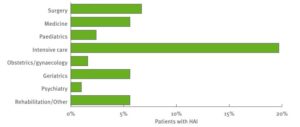Many European countries created national systems for the surveillance of Healthcare-associated infections (HAI), due to the different definitions and methodology of data collection comparison between the countries was impossible before. The HELICS project (Hospitals in Europe Link for Infection Control through Surveillance) was the first step towards the standardization of HAI data [1, 2]. HELICS was a Europe-wide HAI surveillance program launched in 1994, mainly focusing on surgical site infections [3].
The European Union established the European Centre for Disease Prevention and Control (ECDC) in 2005, aimed at strengthening Europe’s defenses against infectious diseases. ECDC works in partnership with national health authorities, and pools Europe’s health knowledge. One of ECDC’s mission is to provide scientific evidence for decision-makers. To fulfill this goal, ECDC keeps surveillance systems in many fields, including HAI, and regularly publishes the data [4].
After several harmonization steps, ECDC now collects, analyzes and publishes surveillance data through TESSy (The European Surveillance System). All the 28 EU member states and 3 other countries from the European Economic Area report regularly. TESSy have several units, and IPSE (Improving Patient Safety in Europe) particularly contains HAI data [5].
Although the gold standard is continuous surveillance, repeated point prevalence surveys (PPS) represent a more feasible alternative for HAI reporting [3]. In the case of PPS, data is collected on one single day [6].
In 2008, ECDC estimated the prevalence of HAIs to be on average 7.1% in EU acute care hospitals, based on a review of 30 PPS carried out between 1996 and 2007, including a total of 837,450 patients. The methodological differences made comparison between countries very difficult, therefore ECDC proposed that HAI shall be measured in a standardized way throughout the European Union [3].
In 2010, ECDC piloted a standardized PPS in 66 hospitals from 23 countries. Based on this study, 7.1% of patients had at least one HAI in European acute care hospitals. Prevalence results were highest in intensive care units, with 28.1% of patients with HAI. ECDC finalized the new protocol for a PPS of HAI in acute care hospitals in 2011 [3].
In the latest PPS, organized in 2011–12, HAI prevalence was 5.7%, meaning more than 80,000 patients with HAI on any given day. Annual number of patients with HAI was estimated at 3.2 million in European acute care hospitals. HAI prevalence was highest in the intensive care units (ICU); 19.5%. ICU patients accounted for 5.0% of the total hospital population [7].

Figure 1: Prevalence of HAI. (Source: ECDC: Annual epidemiological report – Reporting on 2011 surveillance data and 2012 epidemic intelligence data [7].)
The latest surveillance report on intensive care units was published in June 2017, and summarized data gathered in 2014. It claims that 8% of patients acquired HAI when stayed at least two days in an intensive care unit. Most common type of HAI are pneumonia (6%), bloodstream infection (4%) and urinary tract infection (3%). 98% of pneumonia were associated with intubation. 48% of bloodstream infections and 98% of urinary tract infections were catheter-related. It is important to note that only 15 countries submitted data on ICU-acquired infections in 2014 [8].
ECDC conducted two PPS for long-term care facilities (LTCF) in 2010 and in 2013. The latest PPS found that HAI prevalence in LTCF was 3.4%. The total annual number of HAI estimated 4.2 million. On any given day, more than 160,000 residents suffer from HAI. This estimation was higher than the previous based on the 2010 survey [9].
Surveys drew attention that HAI may be underreported, since some cases are not diagnosed or not reported. Degree of underreporting varies by disease and country, therefore direct comparison should still be taken with caution [9]. Table 1 shows main characteristics and results of ECDC surveys.
| Data from | Type | Facility | Particiation | HAI rate | Estimated annual HAI in Europe | Source |
| 2010 | pilot PPS | acute care hospitals | 66 hospitals from 23 countries | 7.1% | n/a | [3] |
| 2011-2012 | PPS | acute care hospitals | 30 countries | 5.7% | 3.2 million | [7] |
| 2014 | surveillance | intensive care units | 15 countries | 8% | n/a | [8] |
| 2013 | PPS | LTCF | 1181 LTCF from 19 countries | 3.4% | 4.2 million | [10] |
| 2010 | PPS | LTCF | 722 LTCF from 28 countries | 2.4% | n/a | [6] |
Table 1: ECDC surveys of HAI
Conclusion:
Healthcare-associated infections are a major public health related threat in Europe [7], millions of citizens suffer from it every year. To evaluate this problem, the HELICS and ECDC surveillance programs was created. ICUs have the highest prevalence of HAI. The majority of HAI in ICUs are associated with the use of invasive devices, and a significant proportion of these HAI could be preventable with proper hand hygiene [8].
Read our previous post on how effective is hand hygiene and how to handrub